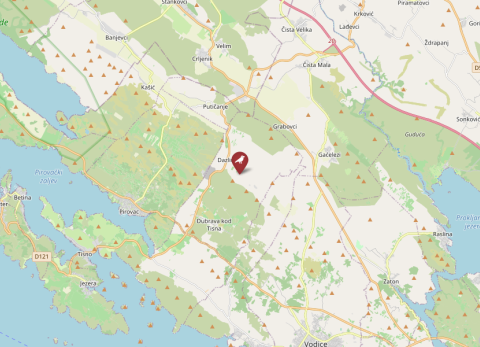| Vegetation Type |
The study site is dominated by agricultural mosaic of small vineyards, olive groves, orchards, as well as hay, cereal and vegetable fields interspersed with uncultivated fields in different stages of succession. In the lowest part of the valley more extensive pastures prevail while valley edges are covered with maquis. In general, habitat in the study plot was highly structured contributing to overall high bird species diversity. |
| Description of study site |
The study area is characterised by gently undulating relief of low limestone ridges. The ridges are generally longitudinal, extending parallel to the coast in northwest-southeast direction. Between ridges are long, narrow and shallow valleys of flysch, marls, sands, diluvial and alluvial deposits. Most of the area is located below 200 m.a.s.l., with only few ridges reaching over 500 m a.s.l. The climate is Mediterranean with hot and dry summers and mild and rainy winters. Climatogenic vegetation is evergreen Holm Oak and Flowering Ash forests in eu-Mediterranean and deciduous Downy Oak and White Hornbeam forests in sub-Mediterranean zone. These associations are not developed in their full form as forests, but are more or less degraded. In shallow valleys geological base with a good water retention capacity enabled development of rich soils. These valleys are dominated by a mosaic of extensively managed, small sized plots (mainly < 0.3 ha) with perennial (mainly cereals - barely, wheat and maize, but also potatoes and other vegetables) and permanent crops (olive groves, vineyards, orchards). Hay, fallow and ploughed fields are also abundant. Shrub vegetation is developed along field borders and on the abandoned plots. Extensive areas of karst limestone ridges and plateaus, with poor soils, are mainly covered with dry rocky pastures in different stage of climatogenic succession. In parts of the limestone area where relief is the most flat olive-groves alternate with overgrown pastures. Highest ridges and steeper slopes are rocky with low and sparse vegetation or almost bare. In most of the study area an increasing process of land abandonment is evident. There is a gradient of land abandonment associated with spatial variation in soil productivity. In valleys, where soils are more productive, abandonment is much less pronounced. On the limestone ridges and plateaus, where soils are poor, land abandonment is especially pronounced – large areas of pastures are in succession stages toward climatogenic forest associations. |

